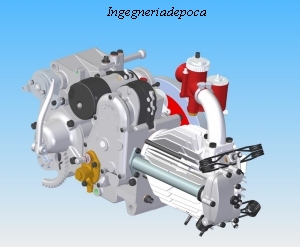We dedicate a series of pages to very famous Moto Guzzi
race models: "Condor", "Dondolino", "Gambalunga". "Condor" was born in 1939 after hybrid models, like the "Nuova C" and the "GTCL", whose particularity was the exasperated research of the lightness of frame and engine. The "Condor" had the frame and the outline of the "GTCL", head and cylinder of the "Nuova
C".
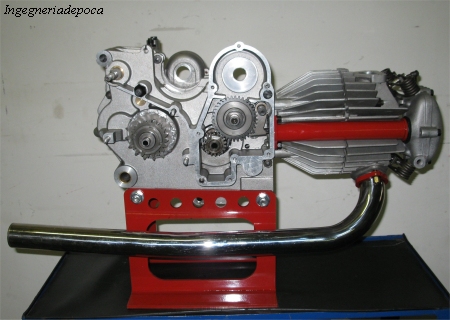
"Dondolino"
engine
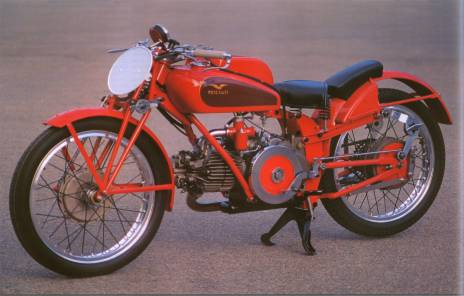
"CONDOR",
build only in 1939 and 1940
In comparison to its predecessors, the "Condor" had the gear mecanism in direct taking to horizontal
shaft. The crank case was therefore different over that melted in electron (alluminium
and of magnesium) and a different (practically new) engine. It was produced in 69 pieces that went to the italian road "Milizia" (Police) and they were also used for the championships (and, during the war, as relay race). After the war, in 1946, the "Condor" was upgraded in the frame and in the
engine; because its poor stability , it was called "Dondolino" ("Swing
chair").
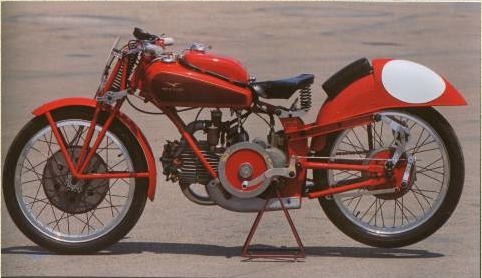
"DONDOLINO",
build from 1946 since 1951
In comparison to the "Condor", the "Dondolino" had a more beautiful layout and it had greater brakes and greater performances with
different camshaft profile. "Dondolino" was produced in 30 pieces for private racer; it had long life, up to 1951. The "Gambalunga" (= "Long legs")
cause long stroke is born together with the "Dondolino" in 1946 and it was even more used in the races competition because used for the official pilots Guzzi. It was a pure racing motorcycles and it never participated in competitions leading like the Milan-Taranto. Done in 11 or 13 bikes it had a long
stroke engine, as for other it reigned then, but the choice was appropriate not and in 1948 he returned to the short
stroke 82 against 90. Practically it mounted the engine of the "Dondolino" that in that year
1948 it adopted a third bearing to sustain the heavy flywheel.
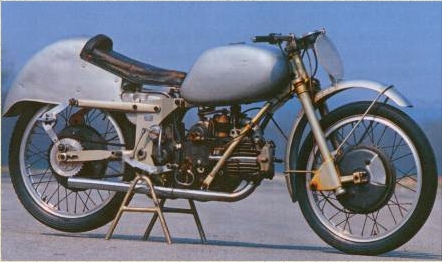
"GAMBALUNGA",
from 1946 since 1951
This change is denominated "Faenza" because brought in concomitance the competition on the circuit of that Italian town. Extraordinarily light motorcycle braked better and from the grey color with a very modern line. Also, the fork was an innovative type, "Earles ", a light and stable frame with a single-cylinder (38 HP); it was a formidable motorcycle. But then the competitors "pluricilindrical" motorcycles began to be stable and
handble and Guzzi thought to divide the models,The historical value of these three "Moto Guzzi" models is enormous.
In the picture the crank gear of the "Dondolino Faenza" is shown, but that however it is not very dissimilar from the other models.
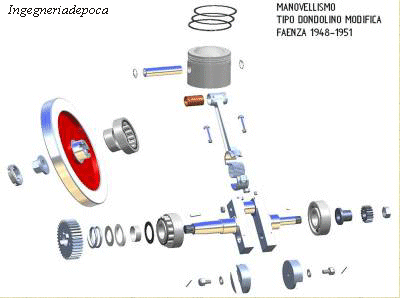
"Dondolino
Faenza" crank gear with 3th bearing
About crank
gear , in the "Guzzi" engines there is a constant that is the cylinder "offset" vs the engine shaft (various millimeters). This technic solution was used by the "Normale" (1921) up to the Fifty. The purpose is to reduces the lateral side push on the reed on the advantage of the
wear. Although this solution became "old" for other motorcycles
marques, the "Guzzi" continued to use this solution to be more reliable than the other engines and it preserved this big "offset". In the figure it is shown the "offset of the piston.

Inertial
forces in a "Dondolino" Crank shaft at 5500 rpm.
The
"asymmetry" is caused by a strong offset
To study better the three engine we have built the crank
case. The plans were realized away from the modern techniques of copying but with a long work we studied the shapes and we transform them in plans for the modellist. Finally, the emotion of the thick raw fusion as it suits him to congruent techniques to the
past.
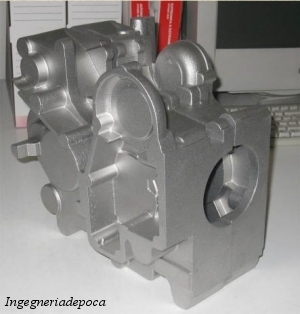
Pair of raw
crank case of fusion, side distribution and flywheel; see the great compactness
Observing the crank cases we notice that the planning in the "Guzzi" house was always the top: in fact the crank cases seems sculpture cause their dimensions and manifacturing. According to "Guzzi" style, the technicians thought noting had to break during a race or a competition also. These reasons were imperative for the project "Condor", "Dondolino" and "Gambalunga", despite the "lightness" of the bike. Watch the rational study of the nervous systems around the bearings volume rate with uniform distribution of the same.
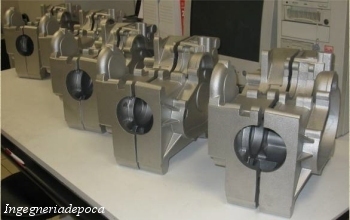
Crank
cases "fresh" of fusion lined up and ready to be worked
Carterds
were produced using all the necessary machines to produce them.
The next photo shows the result- The fusion in Alsi9 is
thermically perfect. All the details were reproduced.
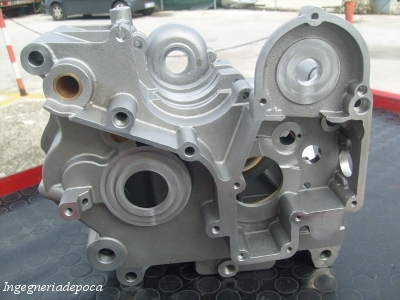
The
coupled carters have pins for center them, like the last models.
They
were tested to dynamometers (see dynamometer)
THE
"FAENZA MODIFICATION" ON "DONDOLINO" ENGINE
(1948)
The
increase of the Guzzi single cylinders engine performances (above
all the RPM) generated flectional stress on the crankshafts.
Mainly caused by the big flyweel positonned too far from the
bearing. Moto Guzzi Factory solved this trouble adding another
bearing (the third bearing) in the transmission cover.
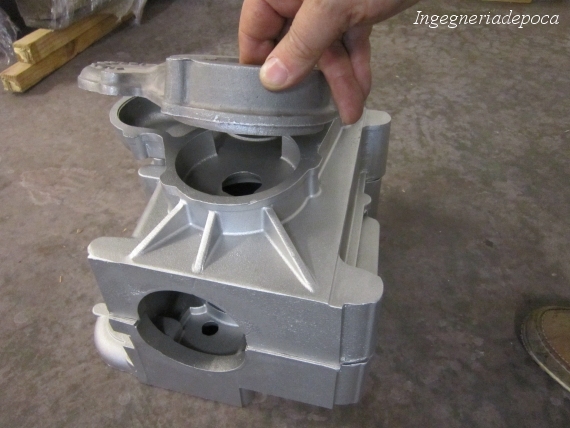
Guzzi
"Dondolino" crankcase shown with the transmission cover.
"Ingegneria d'Epoca" rebuilt this important component to
better study this modification.
The
transmission cover holds the third roller bearing. The machining
must be very accurated to guarantee the co-axiality with the other
two bearings. In the past (Forty-Fifty) this machining was very
difficult but not for Moto Guzzi!
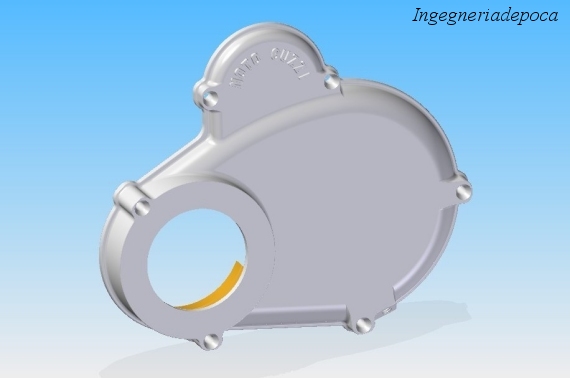
Transmission
cover holding the third bearing, we can see the a part of bronze
bush, "planted" inside the cover.
THE
CYLINDER HEAD
These engine have quite the same cylinders. Only the "Gambalunga" one is quite similar to "Falcone" and "Astore". The cylinders were built in light metal (in that period the engine were built using cast iron). In a first time the engine were not covered, later they were covered for reasons of expansion. The cylinder as also the
crank case shows this symmetry and mighty sketch and elementary at the same time 20 radial-fins spaced of 10� among them.
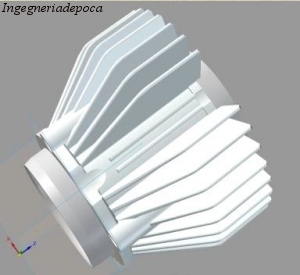
Cylinder with aluminum body and reed in
cast-iron, it differs for the prominence of the reed
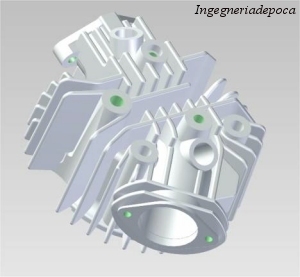
Aluminium
head, like "Condor"
This head of the cylinders (shown in the figure) is the first made in aluminum. "Guzzi" breaks with the ruling tradition up to the Thirtys because a single exhaust system was used instead of the two pipes exhaust system in the GTCL ("Condor" first models) and E.R. In fact, for reasons of space, these two vehicles have only a pot. Casually, "Guzzi" discovered that the the output improved, and immediately was adopted for the races engine (but in aluminum and with an increased alettatura). Later the duct of aspiration (the so-called �pipe�) was fixed with three holes rather than two in the "Dondolino".
Schematically, the distribution is that of the serial models, howewer it differs in a lot of details in the details, like the fasatura, lifts, leverage ratio. The calculation model and ruling construction, at the epoch, was by arcs of circle as shown in the figure.
VALVES
GEAR
The cams of these engines were climbed on
pins rather than bearings (like in the normal motorcycles). The "Dondolino" and "Gambalunga" cams have great basic radius in comparison to the "Condor", so there are very big lobes, the maximum lift is 10 mm about, like in the "Falcon". Then the real lift is the one represented by the arms and the rockers.
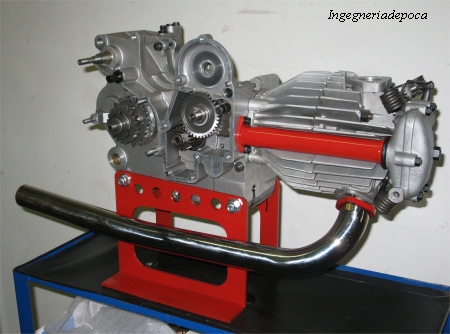
"Dondolino"
engine
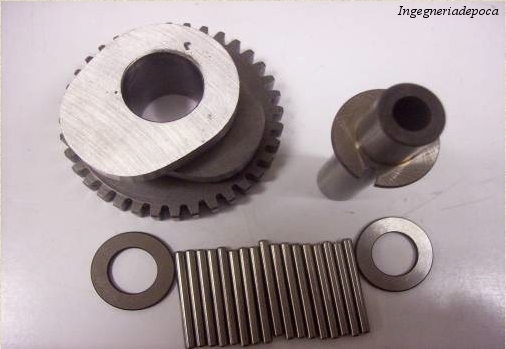
"Dondolino"
cam with pins, see the great base radius
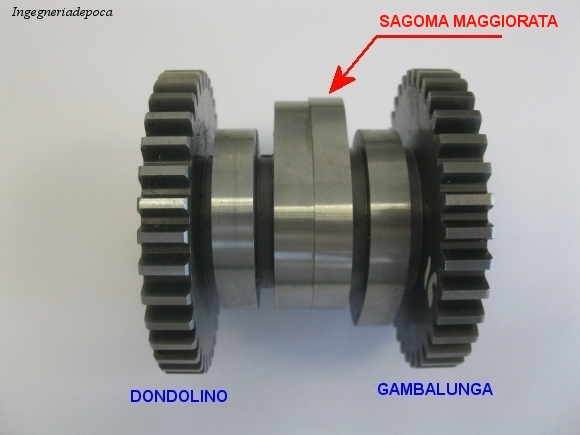
The
two cams in comparison
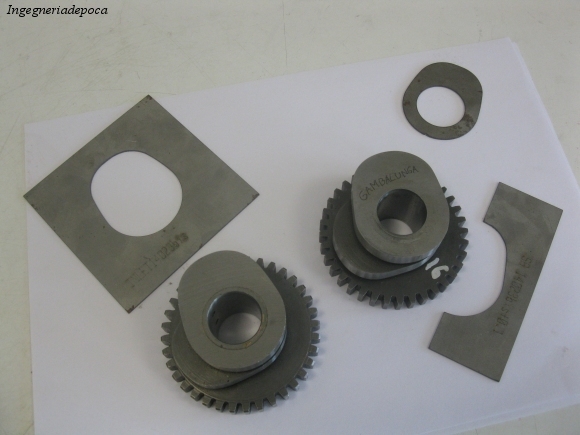
The
"Dondolino" and "Gambalunga" cams in
comparison with some templates
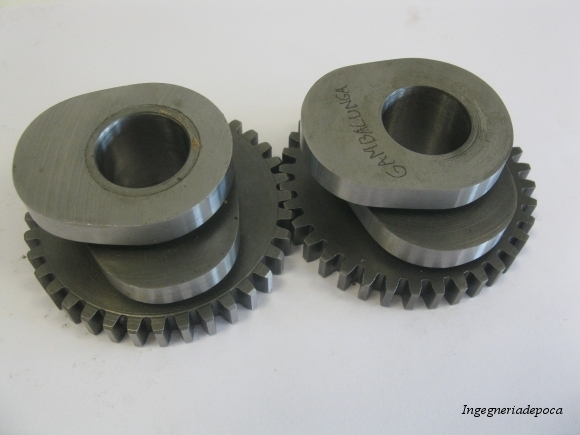
The
same cams in direct comparison
This cam lift has been measured and surely compared with other less motors with high performances.
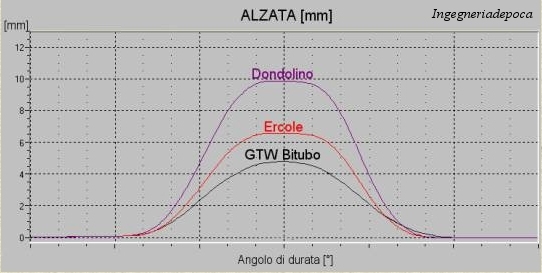
Cam
lift law
CONCLUSIONS
This presentation of these three magnificent and exclusive motorcycles continues and we will
upgrade as soon as possible the reader of the progress of the motorcycles construction. Meantime we realized a publication about these models planning and construction techniques. In particular, there is an article for "Condor", "Dondolino" and "Gambalunga" in
"IL
MANUALE DI INGEGNERIA D'EPOCA" (The
handbook of classic engineering"), abut the
mythical classic Motorbikes Guzzi... and not only!
See "catalog"
web-page.

"
Condor" - "Dondolino" frame, by
"Ingegneriadepoca"!

The
distribuition...
